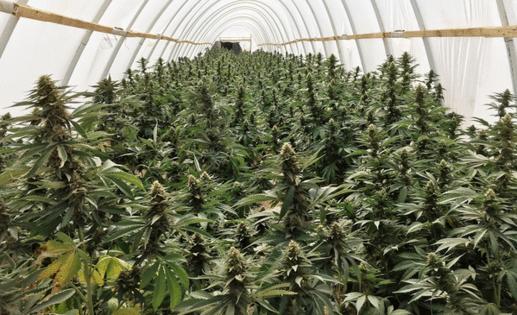Cannabis terpenes shown to prevent pain in new study
Published in Science & Technology News
It's common knowledge that many use cannabis and natural products to treat pain symptoms, especially as the nation reckons with the deadly consequences of the opioid epidemic. But what if aromatic compounds in cannabis could treat chronic pain alone, without the side effects of THC?
These aromatic compounds, called terpenes, give cannabis strains their distinct taste and smell. Terpenes are not unique to cannabis: Linalool is the chemical that makes lavender smell, limonine is the primary component of lemons, beta-caryophyllene gives pepper its kick and geraniol makes up citronella and rose oil.
A study published in Springer Nature online in December found that many of these terpenes reduced postoperative pain in mice and alleviated fibromyalgia symptoms.
"The primary interest in my lab is in finding new and more effective ways to treat chronic pain," said John Streicher, professor of neuroscience and pharmacology at the University of Arizona and senior author on the paper. "Over the last few years, we've been publishing our work on chronic pain, finding that the terpenes are actually highly effective at relieving chronic pain."
Researchers continue to learn about the hundreds of compounds, including terpenes, in the cannabis plant. In previous studies, terpenes have been found to reduce pain and inflammation, have calming effects and relieve neuropathic pain from chemotherapy.
But there's much more to learn, especially when translating results from mouse studies to humans and how people actually use terpenes.
To test terpenes' impact on pain relief, Streicher and his colleagues first performed a small surgery on mice under anesthesia to simulate postoperative pain. They also gave mice resperine, which treats high blood pressure and agitation in humans but, in mice, is a common approach for inducing fibromyalgia, as the drug works to create widespread pain, agitation and hypersensitivity.
Researchers then injected the mice with the terpenes linalool, beta-caryophyllene, geraniol or alpha-humulene, the aromatic compound in hops, and measured their impact on pain relief. They also had a control group of mice that did not receive terpenes.
The terpenes geraniol and alpha-humulene, scientists discovered, significantly relieved pain after surgery, and geraniol and linalool significantly reduced fibromyalgia-induced pain. These effects lasted about two hours.
Ryan Vandrey, researcher in the Cannabis Science Lab at Johns Hopkins University School of Medicine and a professor of psychiatry and behavioral sciences, said he's not surprised by the study's results. "There's decent evidence for terpenes' analgesic effects," he said.
The trick will be learning how these same results translate to pain relief in humans. "We do have to distinguish between this experiment and the typical human experience."
The researchers injected the terpenes at a dose of 200 milligrams per kilogram, a high amount for a human. When looking to relieve a headache or nerve pain, people aren't injecting essential oils: They're breathing them in, rubbing it on their skin, taking it as a tincture or smoking terpenes as part of a blend or cannabis flower.
"These are not the doses people would be routinely exposed to in cannabis," said Vandrey. "These terpenes are probably less than 1% of the average flower you'd get at the dispensary."
Josh Kaplan, associate professor in the Behavioral Neuroscience Program at Western Washington University specializing in cannabis terpenes, said he's excited to see any new non-opioid pain treatment work, but agreed that the dose used is "well beyond anything you'd find in a cannabis product."
"People would have to be taking supplements to achieve these benefits," he said.
(Full disclosure: The author worked in Josh Kaplan's lab as a research assistant from September 2018 to January 2021.)
Streicher said they're still figuring out how to extrapolate the results to humans and that the dose wouldn't be directly transferable.
"You have to remember that this is all in mice, and there are other clinically used drugs, like aspirin, that are dosed in this range in mice," he said. "But then when you go to humans, almost every drug is going to be way less. We're still working on figur(ing) out what the effective dose in humans is going to be, how best to deliver it, and so on."
Similar work is being done in Los Angeles in Ziva Cooper's lab at the University of California Los Angeles, which is testing how people use and respond to cannabis in different conditions.
Streicher and colleagues also did not, in this study, look at how terpenes compare to traditional pain medications such as opioids, ibuprofen or acetaminophen and their effects on pain relief, referred to as a positive control. Vandrey thought that addition would have strengthened the study's results.
"That's what is often missing in these kinds of experiments," he said. "But this experiment gives us a really good initial signal."
Kaplan's lab uses what's called a passive inhalation chamber to deliver cannabis compounds and terpenes to mice. Think of a clear shoebox with a vaporizer attached, so the mice inhale the substance similar to how a human would smoke.
Streicher's lab recently acquired a passive inhalation chamber they'll start using for future experiments. He also recently tested sublingual (under the tongue) terpene administration in mice and found it worked well.
Cannabis and terpene researchers interviewed also stressed the issue of unregulated supplements and how that may impact the consumer experience of wellness products like terpenes.
"People are definitely interested in natural products in their health care," said Vandrey. "But we need to do more research on these isolated natural products."
Streicher's lab has tested terpenes they bought online and at smoke stores for their components and confirmed that many products that purport purity are often unreliable.
"A true essential oil is going to have a ton of terpenes in it," he said. "But our testing has shown, some of these are not very good."
(Streicher disclosed that he has a consulting role for the company Black Rock Nutraceuticals, which makes terpene products. Neither the company nor its products were involved in the research).
They're still elucidating exactly how terpenes work to relieve pain in the brain and body, with a potential mechanism found in a specific kind of adenosine receptor. These receptors are found in the spinal cord and in an area of the brain responsible for muscle movement, addiction and habit formation. Theirs seems to be the first paper that has implicated this specific receptor in how terpenes are involved in pain relief.
"We're trying to break new ground and figure out exactly what's going on," said Streicher.
_____
© 2025 the Pittsburgh Post-Gazette. Visit www.post-gazette.com. Distributed by Tribune Content Agency, LLC.







Comments